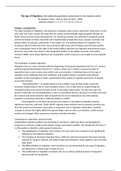Samenvatting
The Age of Migration, by Castles, de Haas en Miller, summary
A summary of the book "The age of Migration" written by Stephen Castles, Hein de Haas and Mark j. Miller (5th edition, 2014). The summary is complete for students following the course Nation and Migration at the VU in Amsterdam. For those who do not follow this course, chapters 4, 6, 8 and 11 are m...
[Meer zien]














